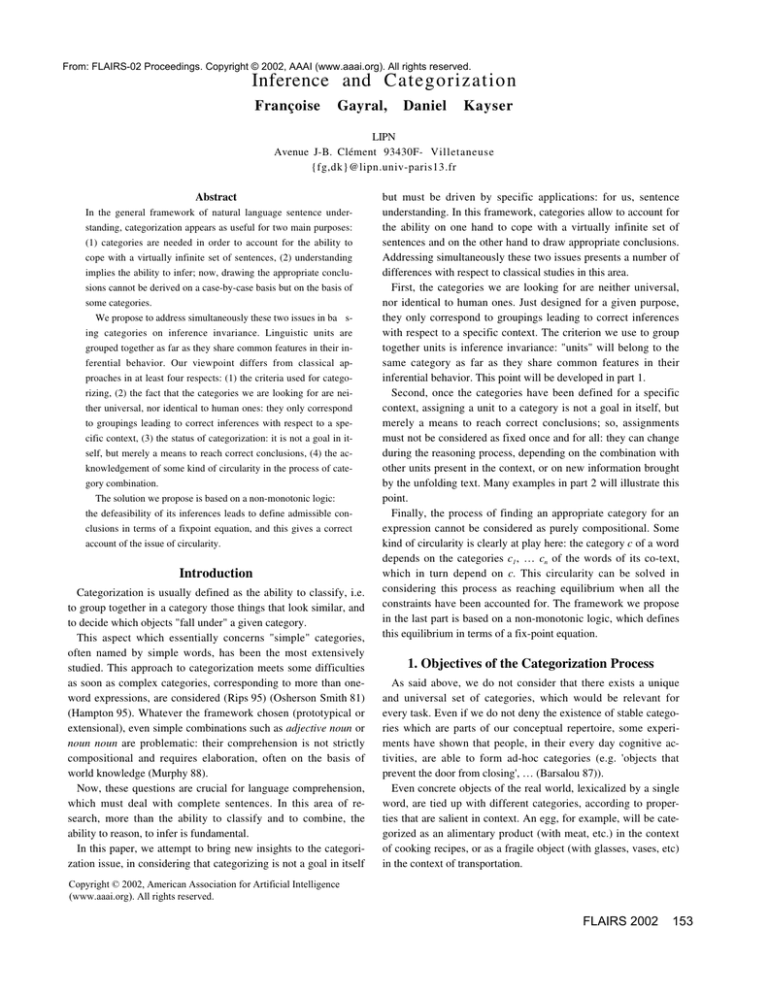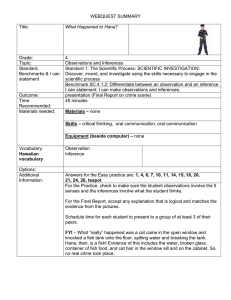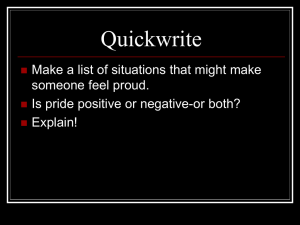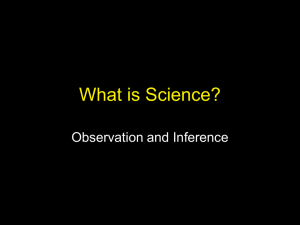
From: FLAIRS-02 Proceedings. Copyright © 2002, AAAI (www.aaai.org). All rights reserved.
Inference and Categorization
Françoise
Gayral,
Daniel
Kayser
LIPN
Avenue J-B. Clément 93430F- Villetaneuse
{fg,dk}@lipn.univ-paris13.fr
Abstract
In the general framework of natural language sentence understanding, categorization appears as useful for two main purposes:
(1) categories are needed in order to account for the ability to
cope with a virtually infinite set of sentences, (2) understanding
implies the ability to infer; now, drawing the appropriate conclusions cannot be derived on a case-by-case basis but on the basis of
some categories.
We propose to address simultaneously these two issues in ba sing categories on inference invariance. Linguistic units are
grouped together as far as they share common features in their inferential behavior. Our viewpoint differs from classical approaches in at least four respects: (1) the criteria used for categorizing, (2) the fact that the categories we are looking for are neither universal, nor identical to human ones: they only correspond
to groupings leading to correct inferences with respect to a specific context, (3) the status of categorization: it is not a goal in itself, but merely a means to reach correct conclusions, (4) the acknowledgement of some kind of circularity in the process of category combination.
The solution we propose is based on a non-monotonic logic:
the defeasibility of its inferences leads to define admissible conclusions in terms of a fixpoint equation, and this gives a correct
account of the issue of circularity.
Introduction
Categorization is usually defined as the ability to classify, i.e.
to group together in a category those things that look similar, and
to decide which objects "fall under" a given category.
This aspect which essentially concerns "simple" categories,
often named by simple words, has been the most extensively
studied. This approach to categorization meets some difficulties
as soon as complex categories, corresponding to more than oneword expressions, are considered (Rips 95) (Osherson Smith 81)
(Hampton 95). Whatever the framework chosen (prototypical or
extensional), even simple combinations such as adjective noun or
noun noun are problematic: their comprehension is not strictly
compositional and requires elaboration, often on the basis of
world knowledge (Murphy 88).
Now, these questions are crucial for language comprehension,
which must deal with complete sentences. In this area of research, more than the ability to classify and to combine, the
ability to reason, to infer is fundamental.
In this paper, we attempt to bring new insights to the categorization issue, in considering that categorizing is not a goal in itself
but must be driven by specific applications: for us, sentence
understanding. In this framework, categories allow to account for
the ability on one hand to cope with a virtually infinite set of
sentences and on the other hand to draw appropriate conclusions.
Addressing simultaneously these two issues presents a number of
differences with respect to classical studies in this area.
First, the categories we are looking for are neither universal,
nor identical to human ones. Just designed for a given purpose,
they only correspond to groupings leading to correct inferences
with respect to a specific context. The criterion we use to group
together units is inference invariance: "units" will belong to the
same category as far as they share common features in their
inferential behavior. This point will be developed in part 1.
Second, once the categories have been defined for a specific
context, assigning a unit to a category is not a goal in itself, but
merely a means to reach correct conclusions; so, assignments
must not be considered as fixed once and for all: they can change
during the reasoning process, depending on the combination with
other units present in the context, or on new information brought
by the unfolding text. Many examples in part 2 will illustrate this
point.
Finally, the process of finding an appropriate category for an
expression cannot be considered as purely compositional. Some
kind of circularity is clearly at play here: the category c of a word
depends on the categories c1 , … cn of the words of its co-text,
which in turn depend on c. This circularity can be solved in
considering this process as reaching equilibrium when all the
constraints have been accounted for. The framework we propose
in the last part is based on a non-monotonic logic, which defines
this equilibrium in terms of a fix-point equation.
1. Objectives of the Categorization Process
As said above, we do not consider that there exists a unique
and universal set of categories, which would be relevant for
every task. Even if we do not deny the existence of stable categories which are parts of our conceptual repertoire, some experiments have shown that people, in their every day cognitive activities, are able to form ad-hoc categories (e.g. 'objects that
prevent the door from closing', … (Barsalou 87)).
Even concrete objects of the real world, lexicalized by a single
word, are tied up with different categories, according to properties that are salient in context. An egg, for example, will be categorized as an alimentary product (with meat, etc.) in the context
of cooking recipes, or as a fragile object (with glasses, vases, etc)
in the context of transportation.
Copyright © 2002, American Association for Artificial Intelligence
(www.aaai.org). All rights reserved.
FLAIRS 2002
153
Rather than considering a single set of categories including,
from the very start, all the available information, introducing
different levels for each category seems preferable. As a matter
of fact, reasoning at a simple level with "crude" categories as
long as it is adequate is certainly more efficient. This does not
prevent to refine the categories, to get more specific inferences,
but only when the need arises, following the idea of variable
ontology developed in (Kayser 88).
However, at a given level, the choice of categories is constrained: they must be discriminating in order to yield exactly the
expected inferences while achieving substantial savings in the
descriptions.
1.1. Inferential Behavior
Let us illustrate now what we mean by "inferential behavior" in
considering two sentences in which the word exam occurs in a
school / university context.
(1) Paul left the algorithm exam on his desk.
(2) Paul takes the exam tomorrow.
Clearly, from such sentences, all humans of a given culture
draw more or less the same set of conclusions. Among these,
from (1):
(1a) The subject of the exam has been written, presumably on
paper.
(1b) The paper is now on Paul's desk.
(1c) Anyone having access to the desk can read it, …
From (2):
(2a) There will be tomorrow an examination event with one or
more examiners and Paul as a candidate.
(2b) Paul presumably received a notification with the location
and time of the event.
(2c) Shortly after the event, Paul will get a diagnosis of his
abilities,...
This observation leads us to speak about the inferential potential of the sentence (1) and (2).
Linguistic knowledge is clearly not sufficient, and world
knowledge is strongly required to produce this kind of conclusions. For (1a) and (1b), the interpretation of the verb tense is
important, as well as the acknowledgement that an exam is constituted of a set of questions, generally written on paper. For (2),
the interpretation of the adverbial temporal explains a part of
(2a), while world knowledge about the typical unfolding of this
type of event is necessary for (2b) and (2c).
So, we do not separate, in the inferential potential of a sentence, the inferences that can be considered as enclosed in the
sentence itself from those that are derived by adding world
knowledge. This is in accordance with findings of some psychological experiences which show that readers make practically no
difference between these two kinds of inference (Bransford
Franks 71).
Furthermore, the inferences that can be carried out from a sentence are influenced by a large variety of factors, such as the
particular situation of enunciation, the communication purposes,
the granularity level of the analysis… Nevertheless, we assume
154
FLAIRS 2002
that they form a relatively well-defined set, relatively to a given
level and a given task.
1.2. Method
This general framework being outlined, two main questions
arise:
- How to exhibit the inferential behavior of linguistic elements?
And how to separate among them the common factors from the
discriminating ones?
- How to determine from an expression uttered in a given context, which elements play a crucial role in the inferences?
No currently existing formal tool is capable of doing that. We
just open some tracks for a methodology, the validation of which
would require some extensive experimentation.
The data are, on the one hand sentences and, on the other hand,
conclusions. Varying the parameters of the sentences (modification in the syntactic structure, substitution of the verb / subject /
object / prepositional phrases) leads to observe differences and
similarities in the conclusions; when differences are noticed, we
analyze the reasons explaining them. Since conducting a real
experimental protocol is beyond our skills, our approach is at the
moment more or less introspective; an interdisciplinary collaboration should, in a later phase, validate or invalidate our intuitions.
We illustrate this methodology on the word exam:
Substituting in (1) this word by contract, leaflet, magazine,
poem, story, discourse does not modify the inferences (1a,b,c).
All these words share with exam the property of containing
meaningful information, possessing a written support, and the
fact that the word can refer to this support. So, many relevant
inferences are common and could be accessible through a category, named for example InformationalObject. These inferences are related to the content (e.g. the exam / the discourse is
interesting) as well as to the written support (e.g. the exam / the
discourse was two-pages long).
On the other hand, (2) emphasizes properties related to some
sort of selective event; inferences (2a-c) remain valid if we replace exam by A-level, driving license, job interview,… all of
which evoke a process by which candidates have their capacity in
a particular domain evaluated by an authority. Inferences concerning the different phases of the process, its actors, some
causal relations (the more a candidate has worked, the more
likely he/she is to succeed) can be triggered. This entitles to
define a category which can be named SelectiveProcess.
As said above, the decision to group different units into a category depends also on the level considered as appropriate for the
task in view. The decision is taken according to the balance
between the savings obtained through factorization vs. the importance of the residual specification required to define the behavior of each unit. This residue exists when:
- an unit has a behavior considered as exceptional with respect
to an inferential property of its category; this behavior can be
part of the normal properties of another category, or it can be
specific, e.g. in the case of idioms;
- the unit determines the value of a feature more precisely than
what is known at the level of the category. For illustration in the
InformationalObject category, the nature of the content
(political / union / social for leaflet), the frequency of publication
for newspaper and magazine, the length and the style for
novel,… are specified at the word level, in a similar way as a role
specification in semantic networks (Brachman Schmolze 85).
On another side, properties can be inherited from a higher
level. For example, in (2), properties such as 'occurring in some
place, at a given moment',… should be factorized at a higher
level than SelectiveProcess in a category Process.
1.3. Relationship with Distributional Analysis
The above method bears some similarity with Distributional
Analysis (DA) (e.g. Harris 90): we would like here to stress the
contrast between the two approaches. In DA, the observation of
the occurrence of words in corpus is seen as a sufficient source
for semantics; the category or class of a given word is equated to
the set of contexts in which the word occurs: its distributions.
Contrarily to our approach, a major role is given in DA to syntax,
and extra-linguistic features are neglected. The same hypothesis
is assumed in statistical approaches, which consider narrow
contexts of the words to measure word similarity (Kohonen 77)
(Lin 98). For example, in (Honkela 97), Self-Organizing Maps
are used to build word-category maps that can be considered as
implicit categories emerging during the learning process.
Such approaches are very helpful in the domain of Information
Retrieval and confer a kind of objectivity to the process of categorization, but their final results are probabilistic in nature. In the
best case, they yield a working set of categories sharing common
semantic features as a by-product of the fine tuning of statistical
parameters, not as a result of a principled study of legitimate
inferences.
For our goal, text understanding, the latter study seems more
suitable, and building categories on inference invariance massively attested under precise and controlled circumstances looks
more appropriate than DA. But we should be aware that a major,
unsolved difficulty about inference is the necessity to represent
world knowledge and its use.
2. Context-dependent Assignment
In this section, we further constrain our scope in focusing on a
specific application: the study of car-crash accident reports sent
by French drivers to their insurance company. The main reason
for doing so is to base our work on real texts, rather than on
artificial examples. Besides, doing so limits the world knowledge
at play, reduces polysemy: the word feu, which we discuss below, that might otherwise correspond to fire, light, shot, burn,…
is always interpreted here as traffic light; finally, the situations of
enunciation and the task (seeking for the responsibility of the
actors in the accident) are well defined.
If we want to find relevant categories for feu in that context, we
observe that:
♦ Feu as well as stop (both the signpost and the line on the
ground), traffic sign, yellow line,… have as functionality the
regulation of the traffic and are related to a "legal framework";
their meaning is pure convention; their physical materialization
should be made very visible, and so on. A category RoadTrafficObject will bundle this information, encapsulate deontic
knowledge about what this sign allows / forbids and thus trigger
inferences depending on whether a user respects or not the corresponding traffic rules.
♦ Feu shares with car, warning sign, engine,… the property of
being a physical object containing a device enabling the functionality for which the object has been designed. These common
factors lead to propose a category Device with three facets: the
physical object, the included mechanism, and the process related
to the device.
These potential categories for feu being defined and the existence of general categories such as Location, Time, PhysicalObject being assumed, the assignment of one of these categories to a given occurrence is far from being straightforward.
The traffic light is out of order informs on a property of the
device, not of the object. Knowledge related to the category
Device, such as 'when a device is out of order, its functionality
is not available', added to specific information related to feu (its
functionality consists in regulating the traffic at crossroads)
allows inferences such as 'the cross-roads might be dangerous',
'traffic jams are likely in the surroundings', …
In other sentences1, feu is used as a location: in 'I stopped at
the light', 'drive up to the light', inferences corresponding to
'where'-questions are available. But this is not specifically related
to the word feu: a general characteristic of language is at play
expressing that some words, used in appropriate contexts, receive
the category of a location even though it is not their primary
purpose.
A temporal interpretation is also possible, e.g. when feu cooccurs with vert (green): in 'while I was moving off at the green
light…' the inference corresponds to a 'when'-question.
But the previous examples show also that several categories
can coexist for a single occurrence of the word. This is even
more obvious in the following sentence of the corpus: in 'being
stopped at the three-colored traffic light (red)', the moment and
the location are simultaneously present. More striking in this
sentence is the fact that, although three-color and red seem
straightforwardly belong to the same category, the two adjectives
do not qualify the same facet of feu. The feature three-color
qualifies the (permanent) ability of the Device to emit lights of
three different colors, while red picks up a specific phase of the
Process, and often yields inferences related to temporal and
deontic knowledge. As a matter of fact, 'to pass the three-color
light' has no temporal interpretation and does not lead to con-
1 All the examples of this section are extracted from our corpus.
FLAIRS 2002
155
clude a "wrong" behavior for the driver, contrary to 'to go
through the red light'.
These examples — as well as many others of the corpus —
show that there it makes little sense to endow the word feu with
an intrinsic category. As a matter of fact:
• if we bind it exclusively to one of the above-mentioned
categories, the inferences obtained will, most of the time, be
inadequate;
• if we consider it as a hybrid, say RoadTrafficObject•Device•Location•Time, with respect to Pustejovsky's complex types (Pustejovsky 95), we assume that the set
of its possible categories can be known a priori;
• if we admit that feu is so special that it requires a category
of its own, say Feu , we are sooner or later doomed to abandon
the very idea of a categorization.
The only remaining solution seems thus to consider the assignment of an occurrence to a category as a defeasible choice,
i.e. a choice that can be changed according to subsequent reasoning or new information. We then need to express the rules
which, in a given context and enunciative situation, lead to a
change in the category, knowing that a change may have repercussions over other choices. Although a universal set of such
rules is an unreachable goal at present, it is not unreasonable to
try and identify the rules that work for restricted domains (e.g.
the uses of feu in car-crash reports).
3. Our Proposal
At this point, the requirements for an adequate model have to be
made more precise.
♦ A symbolic approach is needed to endow the system with
explicit representations of the inferential rules and of the sentences on which they operate. Categories are part of the language
of representation.
♦ Most attempts to generalize meet sooner or later the problem
of exceptions, and factorizing inferential behaviors into categories is no exception! Expressing a general behavior at the level of
a category does not prevent from specifying some elements as
being exceptional. Similarly, the rules that embody common
sense or linguistic knowledge possess exceptions as well. Handling exceptions is thus crucial.
♦ The conclusions which have been drawn from the assignment of words to categories are not definitively granted but on
the contrary defeasible, as new information, brought for example
by the unfolding text, can lead to a better assignment. We need a
model which allows to cope with this defeasibility.
♦ The context-dependence of this assignment as outlined in the
previous section is sufficiently pervasive in natural language not
to be considered as an imperfection. But, since it induces some
kind of circularity, an approach relying on the compositionality
hypothesis and thus implying a purely bottom-up mechanism
would be inefficient. As an illustration, in j'ai passé le feu (I went
through the traffic light), it is the mutual influence between the
noun feu and the verb passer which allows to consider feu as a
location and passer as a movement verb although both of them
156
FLAIRS 2002
are strongly polysemic (in passer un examen (take or pass an
exam) passer would not be spatial). We need a model that accounts for this circularity.
All these requirements motivate the need for nonmonotonicity. Technically, various kinds of non-monotonic
logics have been proposed, and they correspond to different
formal hypotheses. Among them, the logic for default reasoning
(Reiter 80) defines the notion of extension as a solution to a fixpoint equation. This allows to represent the equilibrium between
the interpretation of an expression and the interpretation of its cotext, and solves the circularity already mentioned.
Concretely, we use Reiter's semi-normal defaults (Reiter 80)
with the notational convention: A : B [R1] is a shorthand for
A : B ∧ R1 which means: if A is true and if the conjunction B ∧
B
R1 is consistent with what is known, then B is true.
Consider now a word A (e.g. feu) which can belong to two possible categories, say B (e.g. RoadTrafficObject) and C (e.g.
Device)2. Each possibility is enforced only if it is considered as
making sense in the given context. For the sake of simplicity (a
full development would, step by step, carry us too far away), we
represent this state of affairs by two propositions B M and CM
(read: assigning A to category B, resp. C would be meaningful in
the present context).
Two defaults will be a priori applicable:
and
(d2) A ∧ CM : C [R2],
(d1) A ∧ BM : B [R1]
i.e. as long as R1, resp. R2 is consistent (see below), the meaningfulness of an assignment is a sufficient argument to consider it
as a legitimate choice.
Now, in most cases, considering A as a B makes the choice of
C inappropriate and vice-versa. We could express this by a
"strong" statement of exclusion, e.g. B ⇒ ¬C, but this would
forbid the possibility of co-presence. We adopt a milder form:
(d3) B : ¬R2 [R3] and (d4) C : ¬R1 [R3]
If we want to accept the co-presence of the two interpretations,
there is a possibility to override the mutual inhibition between B
and C, by:
(d5) BM ∧ CM : ¬R3 [R1 ∧ R2].
To sum up, let D be the set {d1,...,d4} and D' the set {d1,...,d5}
and A represent the fact that the word occurred, (i) both theories
<{A}, D> and <{A}, D'> have a unique extension containing
neither B nor C: this models the fact that, in the absence of any
statement of meaningfulness, no interpretation of A is proposed;
(ii) both theories <{A, BM}, D> and <{A, BM}, D'> have a
unique extension containing B and not containing C; this models
the fact that if A belonging to category B makes the sentence
meaningful, then the only solution is to consider A as a B; (iii.a)
theory <{A, BM, CM}, D> has two extensions (one containing B
but not C, the other C but not B), i.e. in the absence of an explicit
2
We obviously should not require the set of all possible categories to be known from the beginning of the analysis; rules such as
"if attaching A either to B or C is not satisfactory, then apply
rules for shifts of meaning" exist as well (Kayser Abir 1995).
permission for co-presence, if both readings are meaningful, the
sentence is ambiguous; (iii.b) theory <{A, BM, CM}, D'> adds a
third extension containing both B and C: if both assignments
make sense, allowing for co-presence gives the choice between
mutually exclusive readings (preserving the ambiguity), and a
new reading in which the word has simultaneously the two categories.
Furthermore, the non-monotonicity takes into account the fact
that the meaning of a sentence may appear later: suppose that, at
the time of reading, no meaningfulness statement BM or C M is
derived, hence (case i) A is left uninterpreted; if the subsequent
lines bring evidence that the category B would make sense, i.e.
allow the derivation of BM, the assignment of A to B becomes
effective (case ii); conversely, if we are in case (ii) because of a
default proof of BM, and if afterward some step of the proof is
invalidated, we modify the comprehension of a part of the text,
which, until then, was considered as understood.
For instance, the sentence the traffic light is damaged is
meaningful with two exclusive interpretations (case iii.a): the
pole supporting the traffic light is damaged, or the pole is OK but
the lights are damaged. If we read later that it is lying across the
road, the occurrence of traffic light can no longer be attached to
the category Device, and we fall in case (ii) where only its
attachment to PhysicalObject is sensible.
These various possibilities hint at the adequacy of semi-normal
defaults to handle defeasible categories assignments, and prove
this tool to be flexible enough to give a local permission or interdiction of co-presence, yielding either ambiguous readings (multiple extensions), or multiple meanings of a word as part of the
same reading.
4. Conclusion
We have tried in this paper to promote the idea that categorizing
is not a goal in itself, but a means to achieve savings in the descriptions for a specific goal. As our area of research is natural
language processing and as in this framework, the notion of
inference is fundamental, we have proposed to set this notion at
the heart of the categorization system. A collaboration with other
cognitive fields, e.g. Psychology to set real experiments, would
be interesting to validate the initial categories.
Due to the nature of human language (and cognition), it is unreasonable to hope for an ideal categorization, bringing savings
in the description of inference without counterpart. The counterpart is the necessity of handling exceptions, and this gives at least
theoretically a criterion for the utility of introducing a new category: it is useful as long as it saves more description than it adds
specificities to describe.
We have also shown that the assignment of a category to an
expression is context-dependent, and thus liable to change during
the interpretive process. This process constructs one (or more)
solution(s) to a system of constraints; some of the constraints
originate in the language, but other ones come from knowledge
about the world and the enunciative situation. The proposed
framework uses Reiter's semi-normal default logic, which provides an adequate technical toolbox to represent the equilibrium
reached by a system of constraints as a solution to a fixpoint
equation.
Expressing the constraints remains a difficult task that can be
done only in a very restricted situation, restriction that is also
needed to keep the system tractable.
References
Barsalou, L.W. 1987. The instability of Graded Structure: Implications
for the Nature of Concepts, in U. Neisser (ed.) Concepts and Conceptual
Development, Cambridge Univ. Press.
Brachman, R.J. Schmolze, J.G. 1985. An Overview of the KL-ONE
Representation System Cognitive Science 9: 171-216.
Bransford, J.D. Franks, J.J. 1971. The abstraction of linguistic ideas
Cognitive Psychology 2: 331-350.
Gayral, F. Kayser, D. Lévy, F. 1997. Quelle est la couleur du feu rouge
du Boulevard Henri IV ?, Verbum 19 (1-2): 177-200.
Gayral, F. Kayser, D. 2001. Categorisation seen as factorisation of the
inferential potential: application to the comprehension of utterances,
Cognitive Systems 5(4): 345-371.
Hampton, J.A. 1995. Testing Prototype Theory of Concepts, Journal of
Memory and Language 34: 686-708.
Harris, Z. 1990. La genèse de l'analyse des transformations et de la
métalangue, Langages 99: 9-20.
Honkela, T. 1997. Self-Organizing Maps in Natural Language Processing, Ph.D. thesis, Helsinki.
Kayser, D. 1998. What Kind of Thing is a Concept. Computational
Intelligence 4(2): 158-165.
Kayser, D. 1994. What kind of models do we need for the simulation of
understanding?, in C.Fuchs & B.Victorri, (eds.), Continuity in Linguistic
Semantics: 111-126, John Benjamins.
Kayser, D. Abir H. 1995. A Non-monotonic Approach to Lexical Semantics in P.Saint-Dizier & E.Viegas, (eds.) Computational Lexical
Semantics: 303-318, Cambridge University Press.
Kohonen, T. 1995. Self-Organizing Maps, Springer.
Lin, D. 1998. Automatic Retrieval and Clustering of Similar Words,
COLING ACL vol.II: 768-774
Murphy, G.L. 1988. Comprehending Complex Concepts, Cognitive
Science 12: 529-562.
Nunberg, G. 1979. The non-uniqueness of semantic solutions. Polysemy,
Linguistics and Philosophy 3: 143-184.
Osherson, D.N. Smith, E. 1981. On the adequacy of prototype theory as a
theory of concepts, Cognition 9: 35-58.
Pustejovsky, J. 1995. Linguistic constraints on type coercion, in P.SaintDizier & E.Viegas (ed.) Computational Lexical Semantics, 71-97, Cambridge Univ. Press.
Reiter, R. 1980. A Logic for Default Reasoning, Artificial Intelligence
13, 1-2: 81-132.
Rips, L. J. 1995. The Current Status of Research on Concept Combination, Mind and Language 10 (1/2): 72-104.
FLAIRS 2002
157





